Finance Report: Tesco's Financial Analysis and Valuation
VerifiedAdded on 2021/02/19
|22
|3398
|138
Report
AI Summary
This report presents a detailed financial analysis of Tesco PLC, examining its performance, valuation, and capital structure. The analysis includes an examination of Tesco's income statement, balance sheet, and cash flow statements for the year 2018, along with a comparative analysis with Morrison's. The report delves into ratio analysis, including gross profit ratio, net profit ratio, return on equity, and return on capital. Furthermore, it explores Tesco's valuation using asset-based valuation and dividend valuation models. The report also calculates the cost of debt, equity, and weighted average cost of capital. Finally, the report identifies limitations of financial analysis.

FINANCE
Paraphrase This Document
Need a fresh take? Get an instant paraphrase of this document with our AI Paraphraser
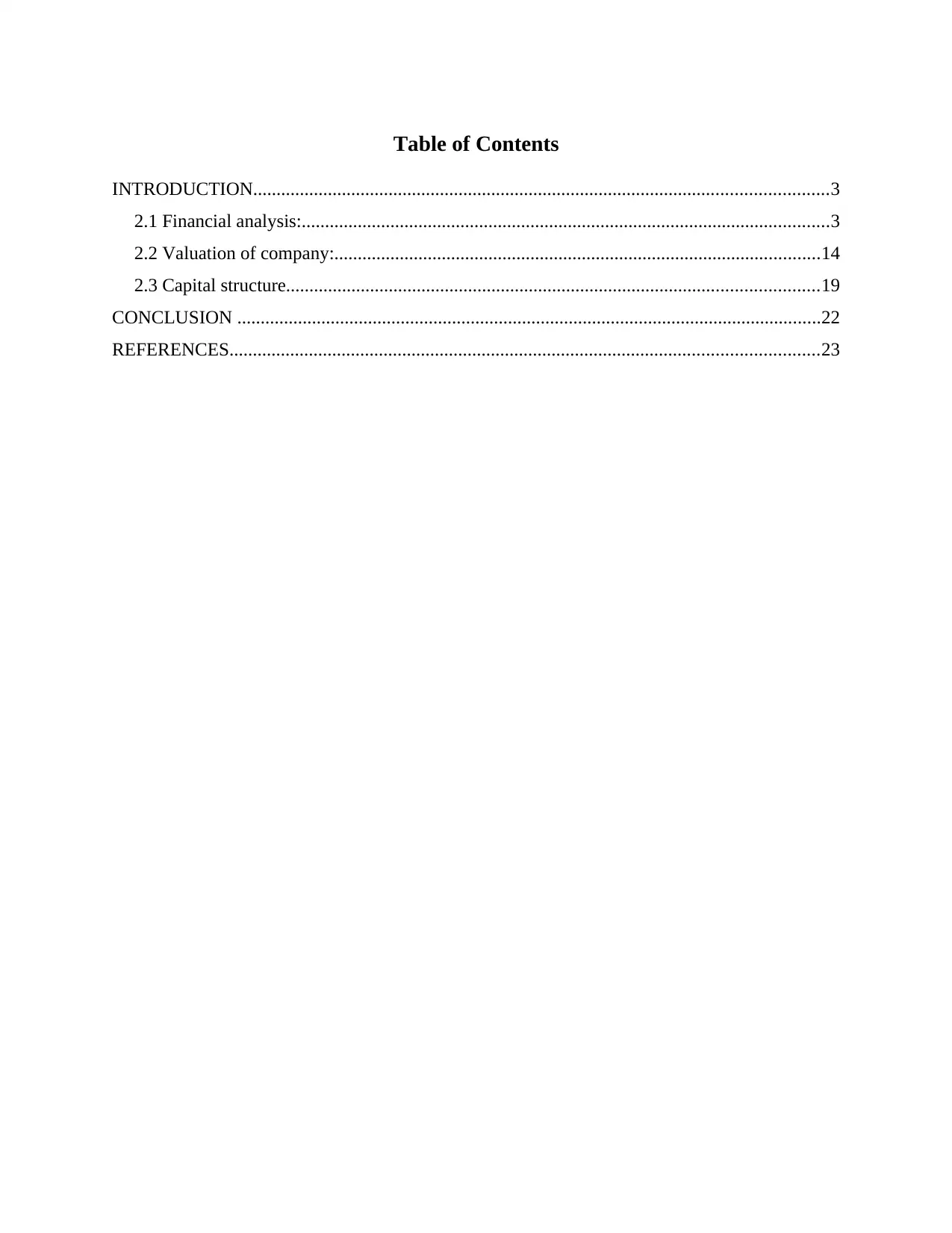
Table of Contents
INTRODUCTION...........................................................................................................................3
2.1 Financial analysis:.................................................................................................................3
2.2 Valuation of company:........................................................................................................14
2.3 Capital structure..................................................................................................................19
CONCLUSION .............................................................................................................................22
REFERENCES..............................................................................................................................23
INTRODUCTION...........................................................................................................................3
2.1 Financial analysis:.................................................................................................................3
2.2 Valuation of company:........................................................................................................14
2.3 Capital structure..................................................................................................................19
CONCLUSION .............................................................................................................................22
REFERENCES..............................................................................................................................23
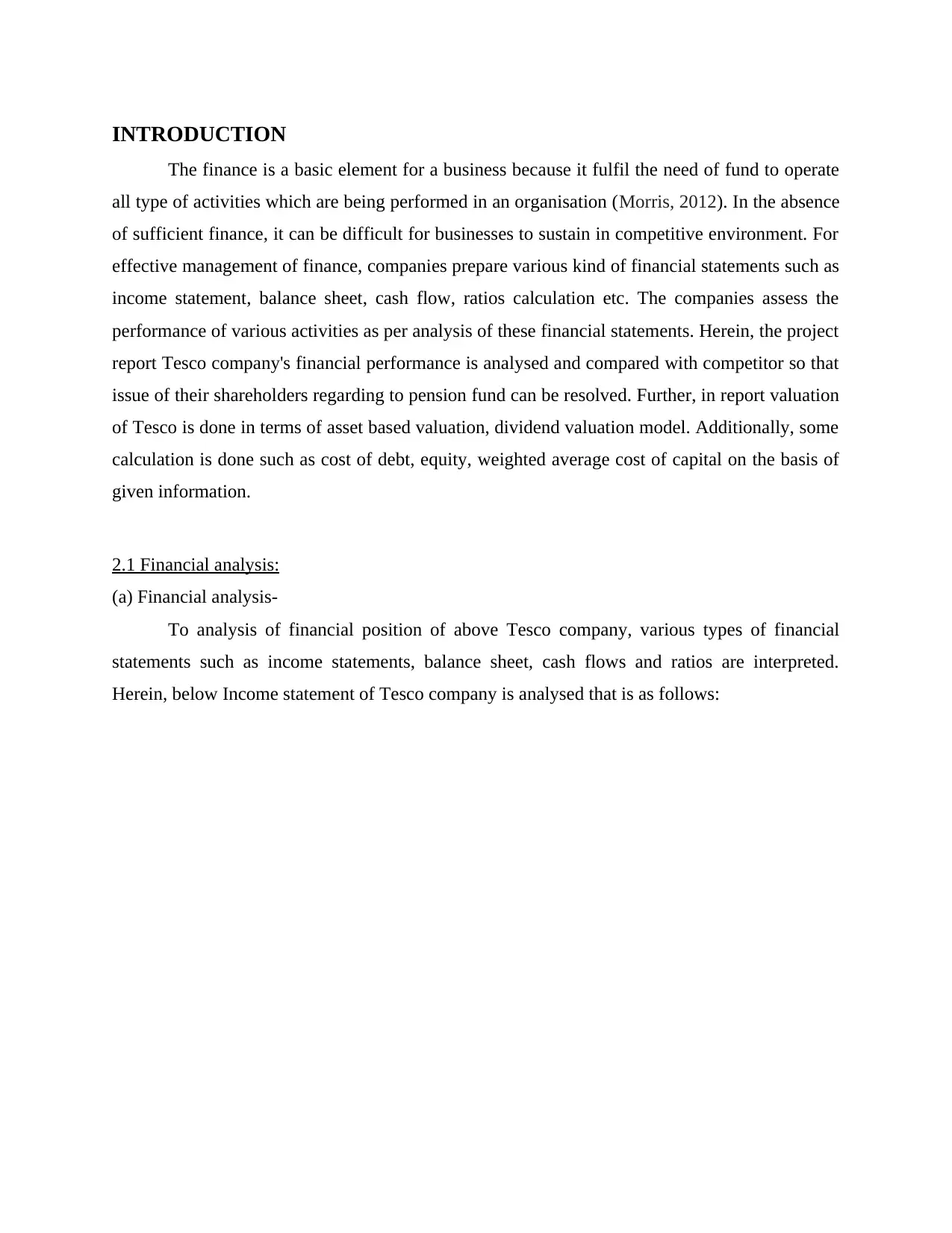
INTRODUCTION
The finance is a basic element for a business because it fulfil the need of fund to operate
all type of activities which are being performed in an organisation (Morris, 2012). In the absence
of sufficient finance, it can be difficult for businesses to sustain in competitive environment. For
effective management of finance, companies prepare various kind of financial statements such as
income statement, balance sheet, cash flow, ratios calculation etc. The companies assess the
performance of various activities as per analysis of these financial statements. Herein, the project
report Tesco company's financial performance is analysed and compared with competitor so that
issue of their shareholders regarding to pension fund can be resolved. Further, in report valuation
of Tesco is done in terms of asset based valuation, dividend valuation model. Additionally, some
calculation is done such as cost of debt, equity, weighted average cost of capital on the basis of
given information.
2.1 Financial analysis:
(a) Financial analysis-
To analysis of financial position of above Tesco company, various types of financial
statements such as income statements, balance sheet, cash flows and ratios are interpreted.
Herein, below Income statement of Tesco company is analysed that is as follows:
The finance is a basic element for a business because it fulfil the need of fund to operate
all type of activities which are being performed in an organisation (Morris, 2012). In the absence
of sufficient finance, it can be difficult for businesses to sustain in competitive environment. For
effective management of finance, companies prepare various kind of financial statements such as
income statement, balance sheet, cash flow, ratios calculation etc. The companies assess the
performance of various activities as per analysis of these financial statements. Herein, the project
report Tesco company's financial performance is analysed and compared with competitor so that
issue of their shareholders regarding to pension fund can be resolved. Further, in report valuation
of Tesco is done in terms of asset based valuation, dividend valuation model. Additionally, some
calculation is done such as cost of debt, equity, weighted average cost of capital on the basis of
given information.
2.1 Financial analysis:
(a) Financial analysis-
To analysis of financial position of above Tesco company, various types of financial
statements such as income statements, balance sheet, cash flows and ratios are interpreted.
Herein, below Income statement of Tesco company is analysed that is as follows:
⊘ This is a preview!⊘
Do you want full access?
Subscribe today to unlock all pages.

Trusted by 1+ million students worldwide
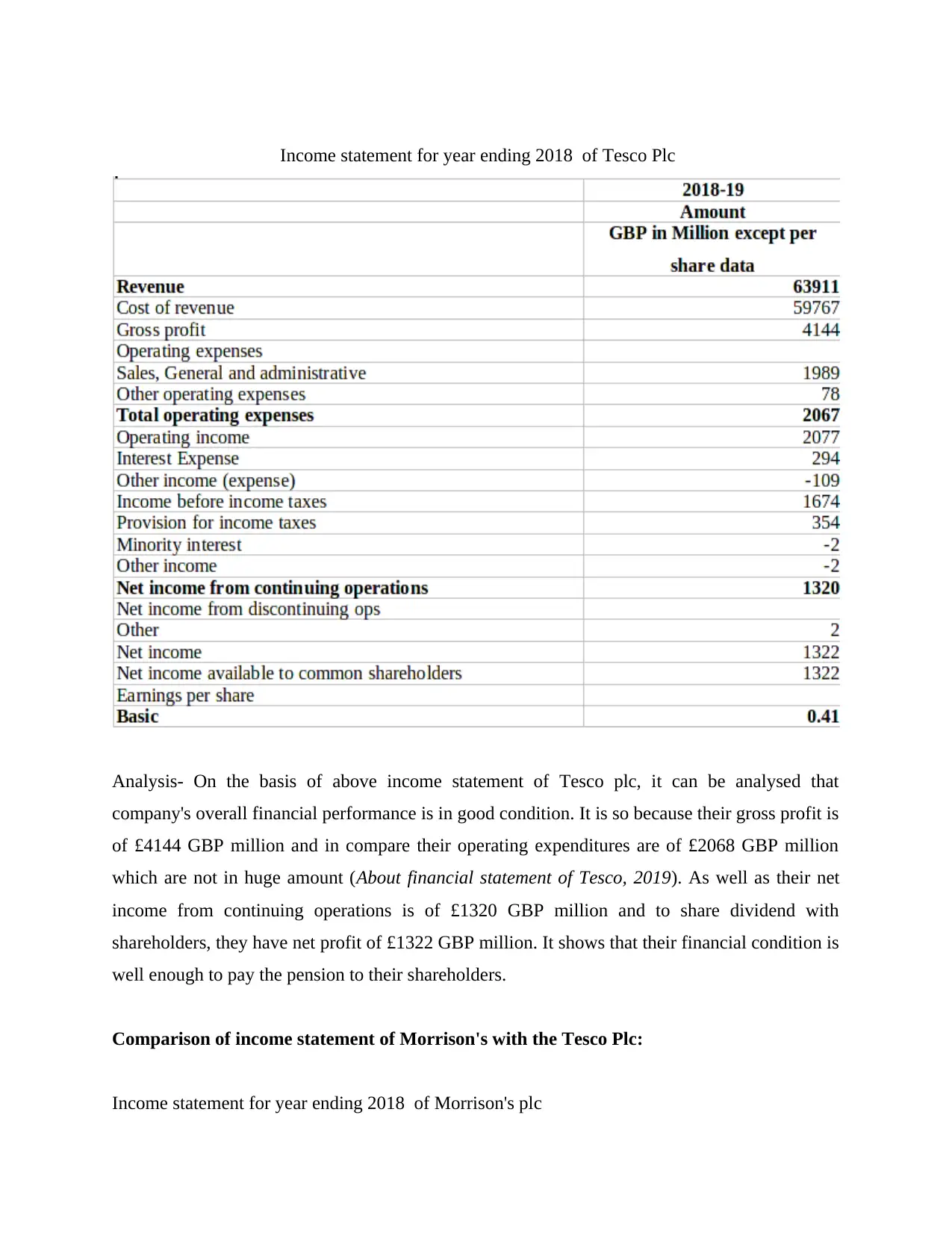
Income statement for year ending 2018 of Tesco Plc
Analysis- On the basis of above income statement of Tesco plc, it can be analysed that
company's overall financial performance is in good condition. It is so because their gross profit is
of £4144 GBP million and in compare their operating expenditures are of £2068 GBP million
which are not in huge amount (About financial statement of Tesco, 2019). As well as their net
income from continuing operations is of £1320 GBP million and to share dividend with
shareholders, they have net profit of £1322 GBP million. It shows that their financial condition is
well enough to pay the pension to their shareholders.
Comparison of income statement of Morrison's with the Tesco Plc:
Income statement for year ending 2018 of Morrison's plc
Analysis- On the basis of above income statement of Tesco plc, it can be analysed that
company's overall financial performance is in good condition. It is so because their gross profit is
of £4144 GBP million and in compare their operating expenditures are of £2068 GBP million
which are not in huge amount (About financial statement of Tesco, 2019). As well as their net
income from continuing operations is of £1320 GBP million and to share dividend with
shareholders, they have net profit of £1322 GBP million. It shows that their financial condition is
well enough to pay the pension to their shareholders.
Comparison of income statement of Morrison's with the Tesco Plc:
Income statement for year ending 2018 of Morrison's plc
Paraphrase This Document
Need a fresh take? Get an instant paraphrase of this document with our AI Paraphraser

Differentiation:
Particular Tesco
(Amount in £ GBP
million )
Morrisons(Amount
in £ GBP million )
Difference
(Amount in
£ GBP
million )
Net income 1320 311 1009
Net income available for
shareholders
1322 311 1011
EBITDA 3343 862 2481
Analysis- On the basis of above comparison of both companies' income statement, this can be
analysed that Tesco seems to be more comparable and strong in compare to Morrisons. It is so
Particular Tesco
(Amount in £ GBP
million )
Morrisons(Amount
in £ GBP million )
Difference
(Amount in
£ GBP
million )
Net income 1320 311 1009
Net income available for
shareholders
1322 311 1011
EBITDA 3343 862 2481
Analysis- On the basis of above comparison of both companies' income statement, this can be
analysed that Tesco seems to be more comparable and strong in compare to Morrisons. It is so

because net income of Tesco plc is of £1320 GBP million while Morrison's income is of £311
GBP million. Along with comparison between both companies' net income is of £1009 GBP
million. As well as availability of net income for shareholders is also different of both
companies. Like £1322 GBP million (Tesco) and £311 GBP million (Morrisons). Hence, as per
the above comparative analysis of both companies, this can be said that Tesco company is
capable for making payment to their shareholders.
Balance sheet of Tesco company for year 2018:
GBP million. Along with comparison between both companies' net income is of £1009 GBP
million. As well as availability of net income for shareholders is also different of both
companies. Like £1322 GBP million (Tesco) and £311 GBP million (Morrisons). Hence, as per
the above comparative analysis of both companies, this can be said that Tesco company is
capable for making payment to their shareholders.
Balance sheet of Tesco company for year 2018:
⊘ This is a preview!⊘
Do you want full access?
Subscribe today to unlock all pages.

Trusted by 1+ million students worldwide
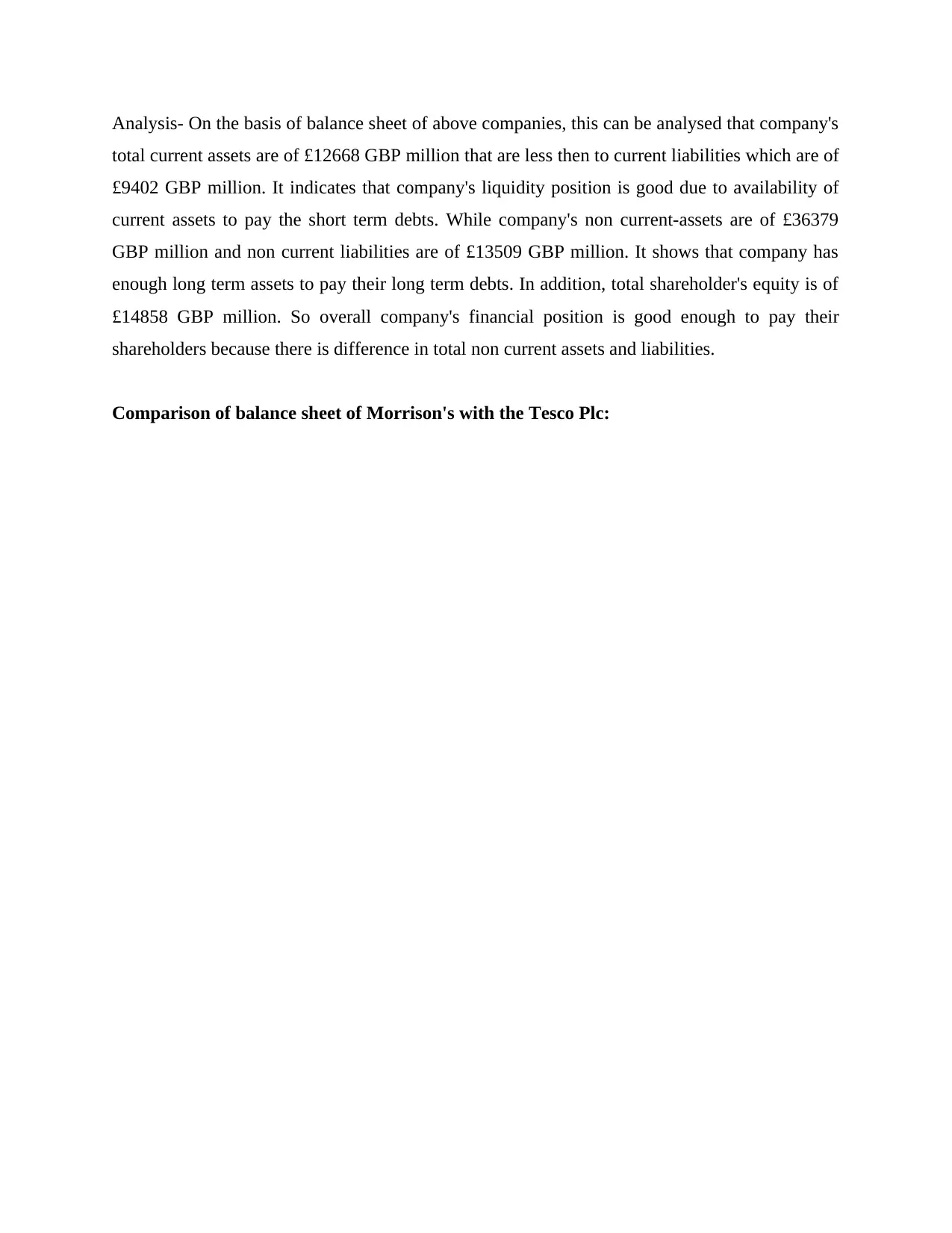
Analysis- On the basis of balance sheet of above companies, this can be analysed that company's
total current assets are of £12668 GBP million that are less then to current liabilities which are of
£9402 GBP million. It indicates that company's liquidity position is good due to availability of
current assets to pay the short term debts. While company's non current-assets are of £36379
GBP million and non current liabilities are of £13509 GBP million. It shows that company has
enough long term assets to pay their long term debts. In addition, total shareholder's equity is of
£14858 GBP million. So overall company's financial position is good enough to pay their
shareholders because there is difference in total non current assets and liabilities.
Comparison of balance sheet of Morrison's with the Tesco Plc:
total current assets are of £12668 GBP million that are less then to current liabilities which are of
£9402 GBP million. It indicates that company's liquidity position is good due to availability of
current assets to pay the short term debts. While company's non current-assets are of £36379
GBP million and non current liabilities are of £13509 GBP million. It shows that company has
enough long term assets to pay their long term debts. In addition, total shareholder's equity is of
£14858 GBP million. So overall company's financial position is good enough to pay their
shareholders because there is difference in total non current assets and liabilities.
Comparison of balance sheet of Morrison's with the Tesco Plc:
Paraphrase This Document
Need a fresh take? Get an instant paraphrase of this document with our AI Paraphraser
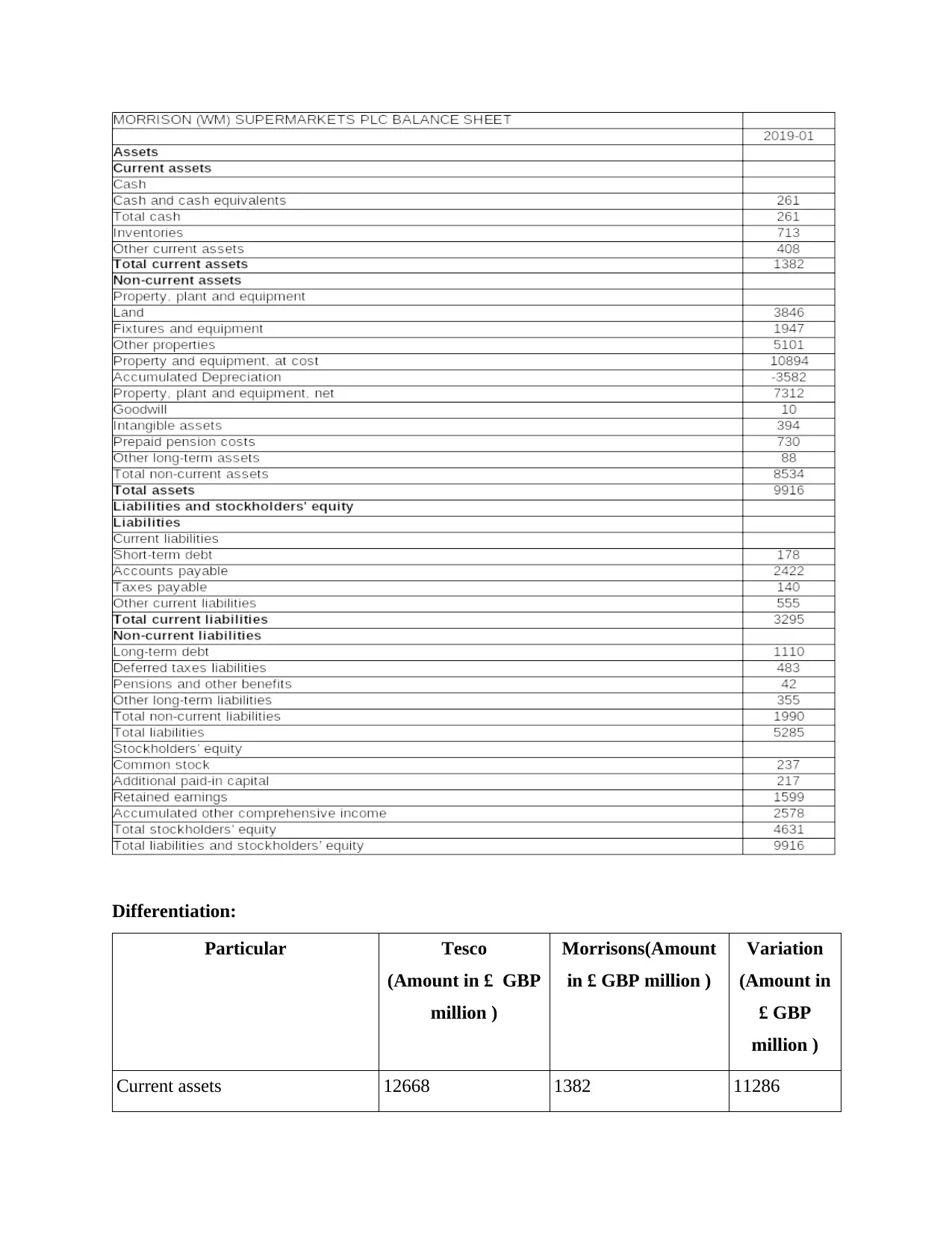
Differentiation:
Particular Tesco
(Amount in £ GBP
million )
Morrisons(Amount
in £ GBP million )
Variation
(Amount in
£ GBP
million )
Current assets 12668 1382 11286
Particular Tesco
(Amount in £ GBP
million )
Morrisons(Amount
in £ GBP million )
Variation
(Amount in
£ GBP
million )
Current assets 12668 1382 11286
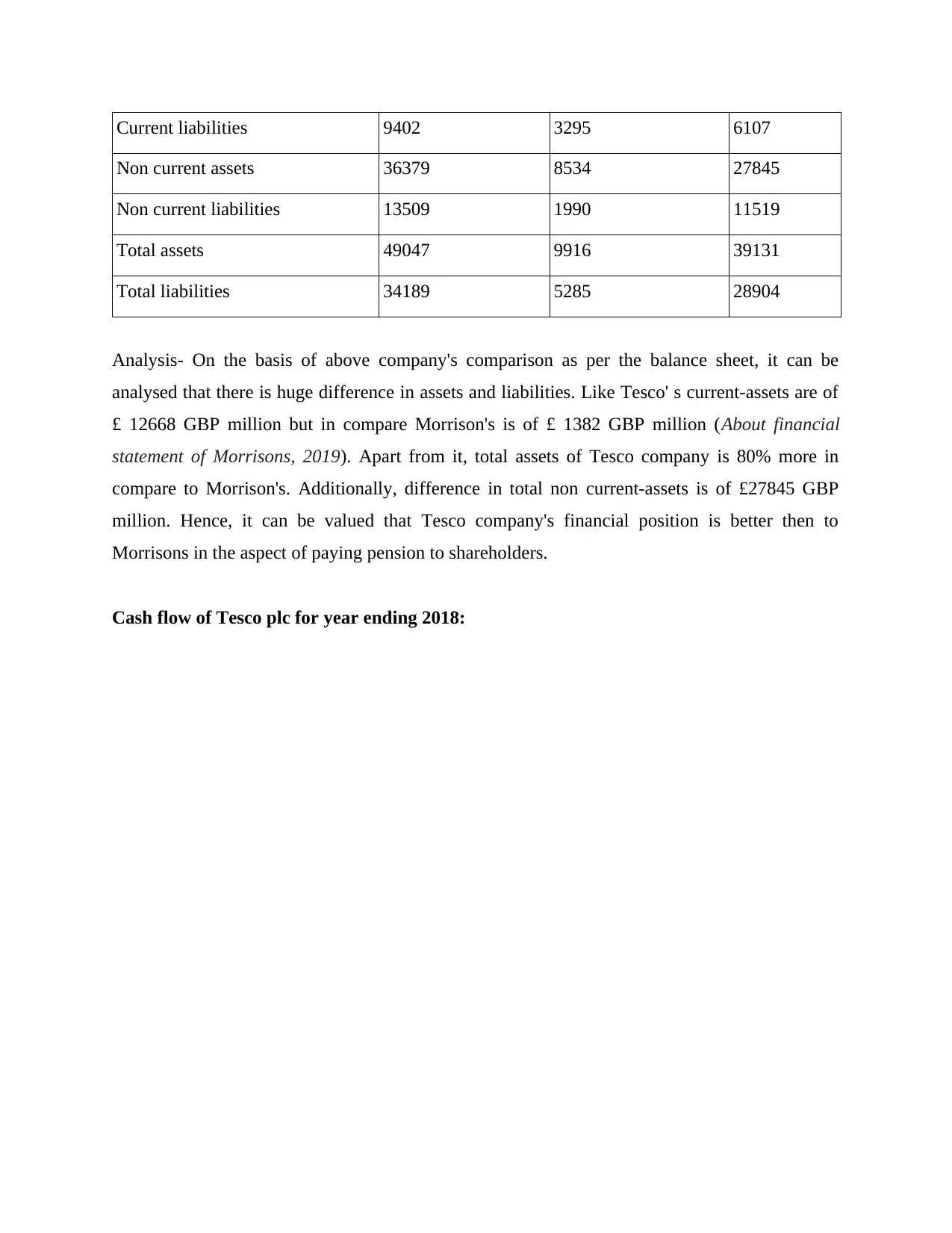
Current liabilities 9402 3295 6107
Non current assets 36379 8534 27845
Non current liabilities 13509 1990 11519
Total assets 49047 9916 39131
Total liabilities 34189 5285 28904
Analysis- On the basis of above company's comparison as per the balance sheet, it can be
analysed that there is huge difference in assets and liabilities. Like Tesco' s current-assets are of
£ 12668 GBP million but in compare Morrison's is of £ 1382 GBP million (About financial
statement of Morrisons, 2019). Apart from it, total assets of Tesco company is 80% more in
compare to Morrison's. Additionally, difference in total non current-assets is of £27845 GBP
million. Hence, it can be valued that Tesco company's financial position is better then to
Morrisons in the aspect of paying pension to shareholders.
Cash flow of Tesco plc for year ending 2018:
Non current assets 36379 8534 27845
Non current liabilities 13509 1990 11519
Total assets 49047 9916 39131
Total liabilities 34189 5285 28904
Analysis- On the basis of above company's comparison as per the balance sheet, it can be
analysed that there is huge difference in assets and liabilities. Like Tesco' s current-assets are of
£ 12668 GBP million but in compare Morrison's is of £ 1382 GBP million (About financial
statement of Morrisons, 2019). Apart from it, total assets of Tesco company is 80% more in
compare to Morrison's. Additionally, difference in total non current-assets is of £27845 GBP
million. Hence, it can be valued that Tesco company's financial position is better then to
Morrisons in the aspect of paying pension to shareholders.
Cash flow of Tesco plc for year ending 2018:
⊘ This is a preview!⊘
Do you want full access?
Subscribe today to unlock all pages.

Trusted by 1+ million students worldwide
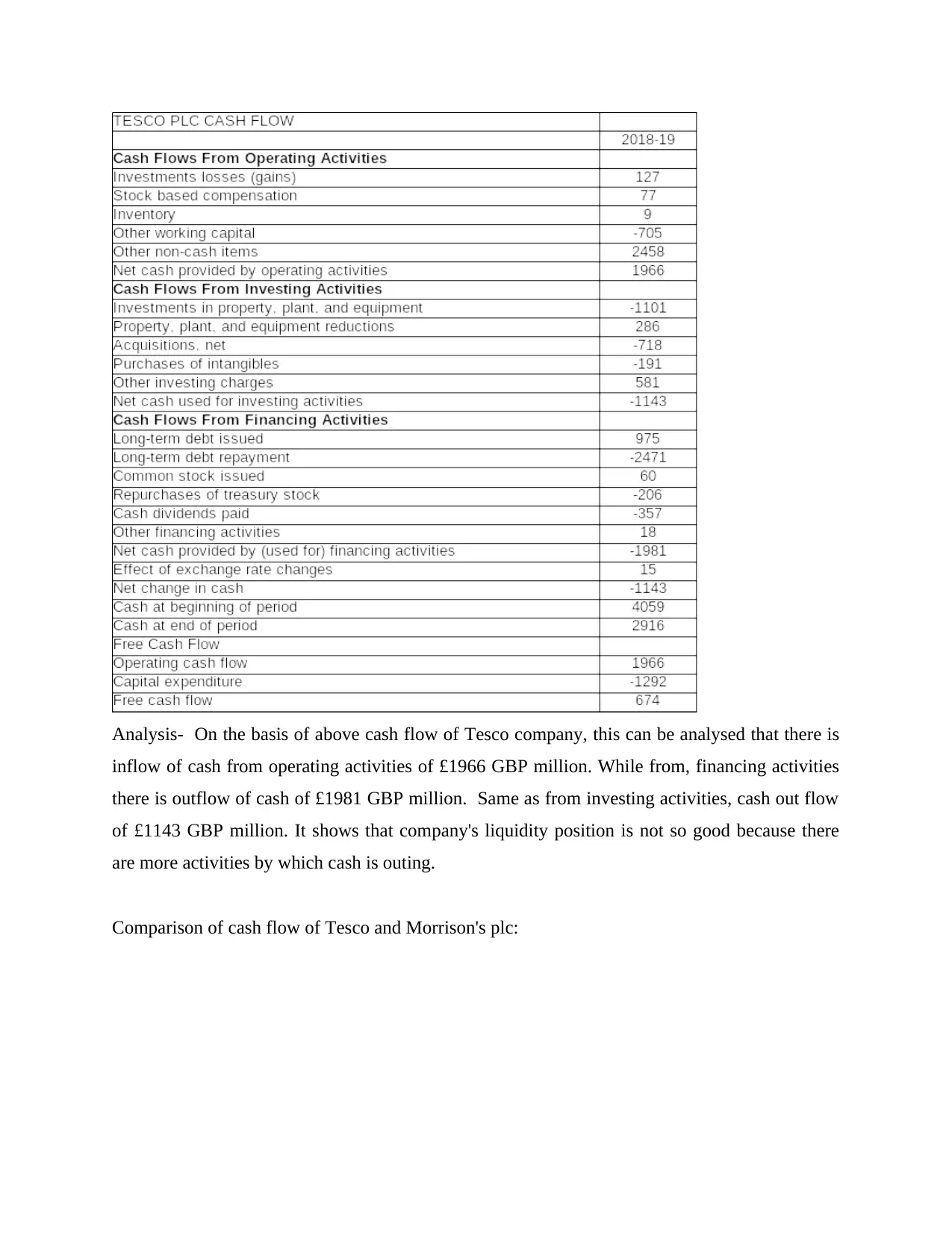
Analysis- On the basis of above cash flow of Tesco company, this can be analysed that there is
inflow of cash from operating activities of £1966 GBP million. While from, financing activities
there is outflow of cash of £1981 GBP million. Same as from investing activities, cash out flow
of £1143 GBP million. It shows that company's liquidity position is not so good because there
are more activities by which cash is outing.
Comparison of cash flow of Tesco and Morrison's plc:
inflow of cash from operating activities of £1966 GBP million. While from, financing activities
there is outflow of cash of £1981 GBP million. Same as from investing activities, cash out flow
of £1143 GBP million. It shows that company's liquidity position is not so good because there
are more activities by which cash is outing.
Comparison of cash flow of Tesco and Morrison's plc:
Paraphrase This Document
Need a fresh take? Get an instant paraphrase of this document with our AI Paraphraser
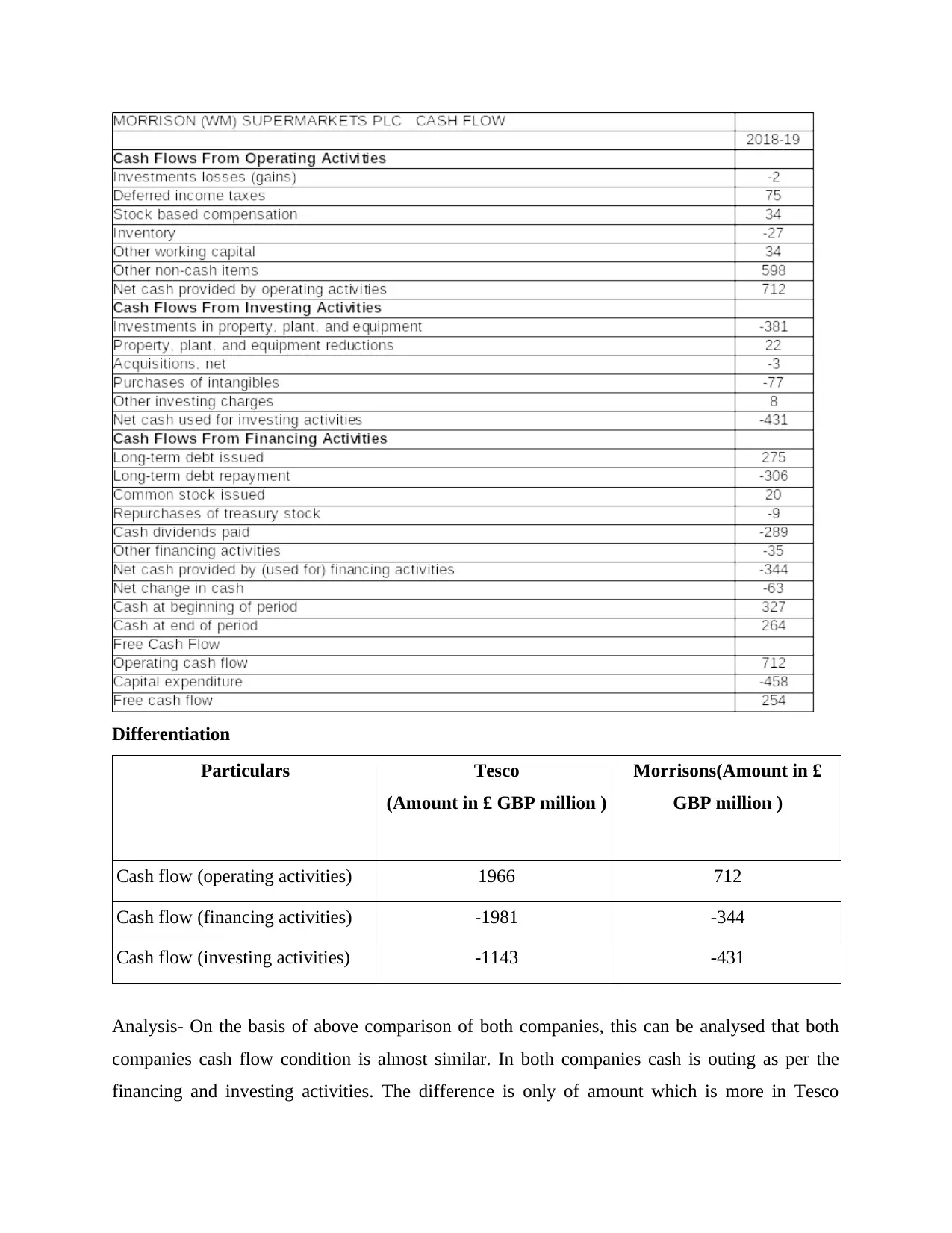
Differentiation
Particulars Tesco
(Amount in £ GBP million )
Morrisons(Amount in £
GBP million )
Cash flow (operating activities) 1966 712
Cash flow (financing activities) -1981 -344
Cash flow (investing activities) -1143 -431
Analysis- On the basis of above comparison of both companies, this can be analysed that both
companies cash flow condition is almost similar. In both companies cash is outing as per the
financing and investing activities. The difference is only of amount which is more in Tesco
Particulars Tesco
(Amount in £ GBP million )
Morrisons(Amount in £
GBP million )
Cash flow (operating activities) 1966 712
Cash flow (financing activities) -1981 -344
Cash flow (investing activities) -1143 -431
Analysis- On the basis of above comparison of both companies, this can be analysed that both
companies cash flow condition is almost similar. In both companies cash is outing as per the
financing and investing activities. The difference is only of amount which is more in Tesco
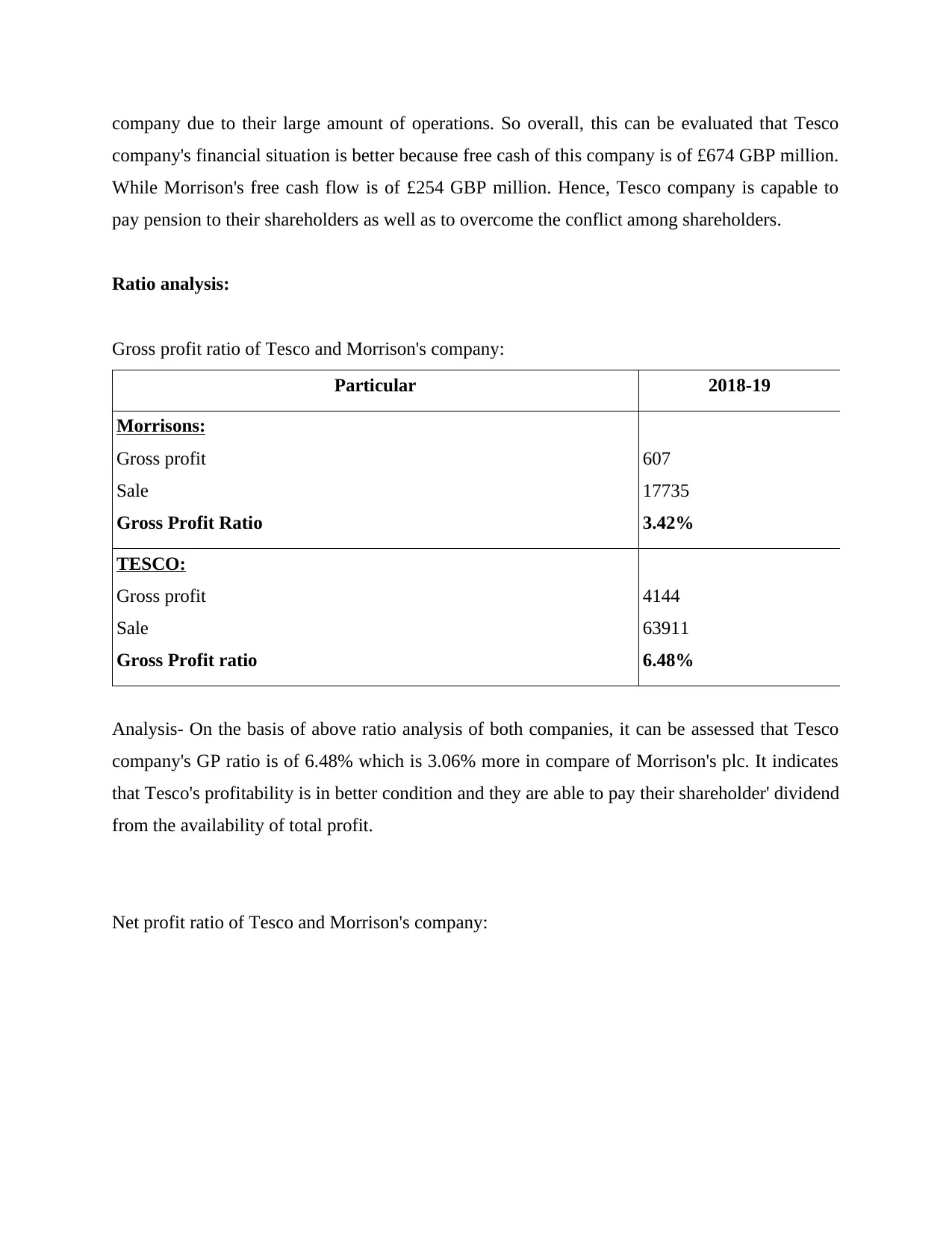
company due to their large amount of operations. So overall, this can be evaluated that Tesco
company's financial situation is better because free cash of this company is of £674 GBP million.
While Morrison's free cash flow is of £254 GBP million. Hence, Tesco company is capable to
pay pension to their shareholders as well as to overcome the conflict among shareholders.
Ratio analysis:
Gross profit ratio of Tesco and Morrison's company:
Particular 2018-19
Morrisons:
Gross profit
Sale
Gross Profit Ratio
607
17735
3.42%
TESCO:
Gross profit
Sale
Gross Profit ratio
4144
63911
6.48%
Analysis- On the basis of above ratio analysis of both companies, it can be assessed that Tesco
company's GP ratio is of 6.48% which is 3.06% more in compare of Morrison's plc. It indicates
that Tesco's profitability is in better condition and they are able to pay their shareholder' dividend
from the availability of total profit.
Net profit ratio of Tesco and Morrison's company:
company's financial situation is better because free cash of this company is of £674 GBP million.
While Morrison's free cash flow is of £254 GBP million. Hence, Tesco company is capable to
pay pension to their shareholders as well as to overcome the conflict among shareholders.
Ratio analysis:
Gross profit ratio of Tesco and Morrison's company:
Particular 2018-19
Morrisons:
Gross profit
Sale
Gross Profit Ratio
607
17735
3.42%
TESCO:
Gross profit
Sale
Gross Profit ratio
4144
63911
6.48%
Analysis- On the basis of above ratio analysis of both companies, it can be assessed that Tesco
company's GP ratio is of 6.48% which is 3.06% more in compare of Morrison's plc. It indicates
that Tesco's profitability is in better condition and they are able to pay their shareholder' dividend
from the availability of total profit.
Net profit ratio of Tesco and Morrison's company:
⊘ This is a preview!⊘
Do you want full access?
Subscribe today to unlock all pages.

Trusted by 1+ million students worldwide
1 out of 22
Related Documents
Your All-in-One AI-Powered Toolkit for Academic Success.
+13062052269
info@desklib.com
Available 24*7 on WhatsApp / Email
![[object Object]](/_next/static/media/star-bottom.7253800d.svg)
Unlock your academic potential
Copyright © 2020–2025 A2Z Services. All Rights Reserved. Developed and managed by ZUCOL.




